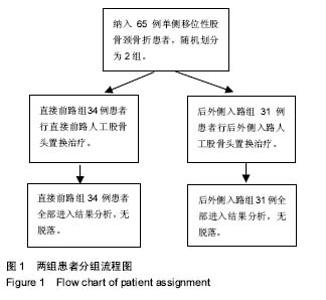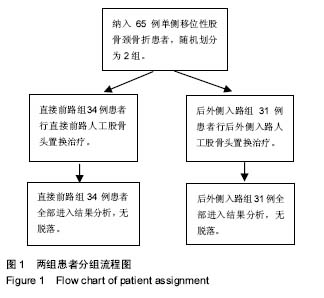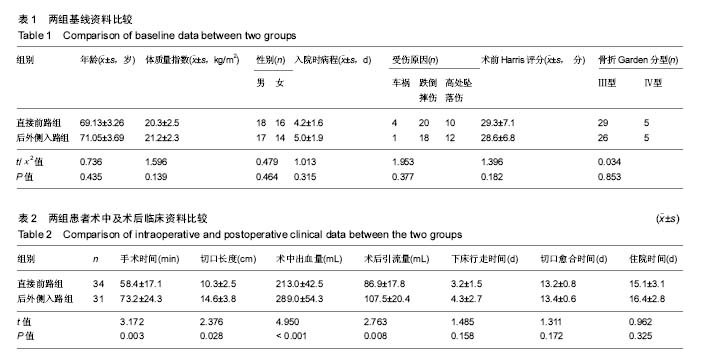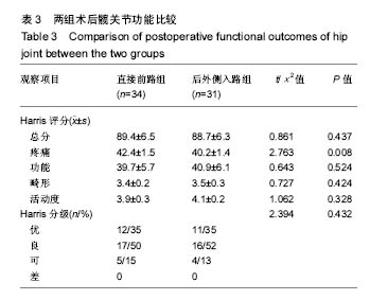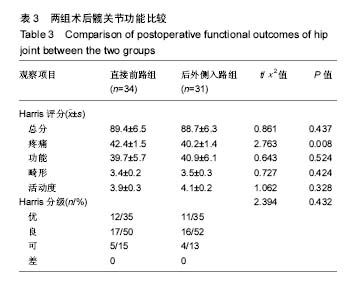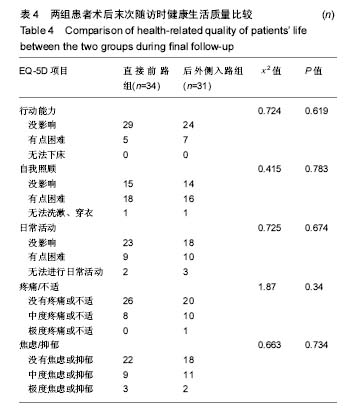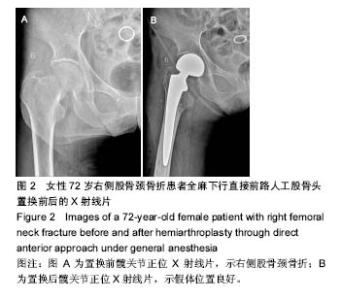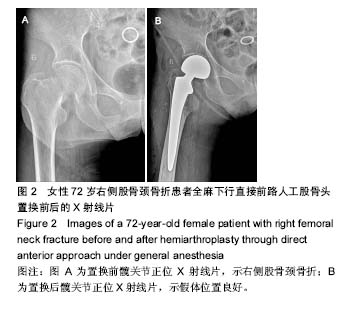| [1] Han SK, Song HS, Kim R, et al. Clinical results of treatment of garden type 1 and 2 femoral neck fractures in patients over 70-year old. Eur J Trauma Emergency Surg. 2016;42(2): 191-196.[2] 张英泽. 股骨颈骨折治疗方案选择策略与进展[J]. 中国骨伤, 2015, 28(9):781-783.[3] 徐辰,毛远青,朱振安. 老年股骨颈骨折治疗进展[J]. 国际骨科学杂志, 2015,36(2):109-113.[4] Yoo JH, Kim KT, Kim TY, et al. Postoperative fever after hemiarthroplasty in elderly patients over 70 years of age with displaced femoral neck fracture: Necessity of routine workup? Injury. 2017;48(2):441-446.[5] 侯洪涛,陈柯,仝昭方,等. 老年GardenⅢ与Ⅳ型股骨颈骨折闭合复位内固定术疗效比较[J].中国医学创新,2016,13(23):49-52.16:59 2018-4-3[6] 王亮,杨冬松,甄相周,等. 老年移位股骨颈骨折髋关节置换术股骨非骨水泥固定的研究[J]. 中国临床研究, 2016, 29(3): 354-356.[7] Yurdakul E, Karaaslan F, Korkmaz M, et al. Is cemented bipolar hemiarthroplasty a safe treatment for femoral neck fracture in elderly patients? Clin Int Aging. 2015;10: 1063-1067.[8] Lin CF, Liang WM. Outcomes after fixation for undisplaced femoral neck fracture compared to hemiarthroplasty for displaced femoral neck fracture among the elderly. BMC Musculoskeletal Disord. 2015; 16(1):199.[9] 辛宗山,郑军,操儒道,等.双极人工股骨头置换术治疗老年股骨颈骨折的长期随访结果分析[J].中国骨与关节损伤杂志, 2015, 30(12):1250-1253.[10] Burgers PT, Hoogendoorn M, Woensel EA, et al. Total medical costs of treating femoral neck fracture patients with hemi- or total hip arthroplasty: a cost analysis of a multicenter prospective study. Osteoporos Int. 2016;27(6):1-10.[11] 关智宇,冯殿鹏. 小切口后外侧入路全髋关节置换术治疗老年股骨颈骨折的效果[J]. 中国医药导报, 2015,12(36):85-88.[12] 韦庆军,赵劲民,陆荣斌,等.以改良Watson-Jones入路微创行全髋关节置换与改良Gibson后侧入路全髋关节置换的近期疗效比较[J]. 中国组织工程研究,2011,15(35):6500-6503.[13] Eto S, Hwang K, Huddleston JI, et al. The direct anterior approach is associated with early revision total hip arthroplasty. J Arthroplasty. 2016;32(3):1001-1005.[14] Goldstein WM, Branson JJ. Posterior-lateral approach to minimal incision total hip arthroplasty. Orthop Clin North Am. 2004;35(2):131-136.[15] 王喆,崔波,程景春,等.单切口双入路法与后外侧入路法在全髋关节置换翻修术中的比较研究[J]. 中国当代医药, 2014,21(26): 50-52.[16] Kazuhiro O, Tatsuya T, Yoko M, et al. Total hip arthroplasty with subtrochanteric shortening osteotomy for Crowe grade 4 dysplasia using the direct anterior approach. J Arthroplasty. 2014;29(3):626-629.[17] 刘晓锋,施水彬. 直接前入路行初次全髋关节置换术的疗效[J]. 实用骨科杂志, 2016, 22(6):507-509.[18] Liang C, Yang F, Lin W, et al. Efficacies of surgical treatments based on Harris hip score in elderly patients with femoral neck fracture. Int J Clin Exp Med. 2014;8(5):6784-6793.[19] Honkavaara N, Al-Ani AN, Campenfeldt P, et al. Good responsiveness with EuroQol 5-Dimension questionnaire and Short Form (36) Health Survey in 20–69 years old patients with a femoral neck fracture: A 2-year prospective follow-up study in 182 patients. Injury. 2016;47(8):1692-1697. [20] 李海峰,亓玉彬,李强,等. 老年人股骨颈骨折手术治疗进展[J]. 中国老年学, 2013, 33(3):721-723.[21] Haentjens P, Autier P, Barette M, et al. Survival and functional outcome according to hip fracture type: a one-year prospective cohort study in elderly women with an intertrochanteric or femoral neck fracture. Bone. 2007;41(6): 958-964.[22] Muir SW, Yohannes AM. The impact of cognitive impairment on rehabilitation outcomes in elderly patients admitted with a femoral neck fracture: a systematic review. J Geriatr Phys Ther. 2009;32(1):24.[23] Macaulay W, Nellans KW, Iorio R, et al. Total hip arthroplasty is less painful at 12 months compared with hemiarthroplasty in treatment of displaced femoral neck fracture. HSS J. 2008; 4(1):48-54.[24] 袁堂波,黄立新,蒋建农,等.双极人工股骨头置换术与全髋关节置换术治疗老年股骨颈骨折疗效比较[J].实用骨科杂志, 2013, 19(6):485-488.[25] 唐朴勤,周雪松,陈晓婷,等.人工股骨头置换与全髋关节置换在治疗老年股骨颈骨折中的疗效比较[J].武汉大学学报(医学版), 2014,35(1):143-145.[26] 林奇益,李玉茂,谢晓勇,等.预防人工全髋关节置换早期后脱位:修复后关节囊及外旋肌群的意义[J].中国组织工程研究, 2014, 18(40):6403-6407.[27] 桑伟林,朱力波,陆海明,等.直接前入路与后外侧入路全髋关节置换术的对比研究[J]. 中华关节外科杂志电子版, 2015,9(5): 584-588.[28] Abe H, Sakai T, Takao M, et al. Difference in stem alignment between the direct anterior approach and the posterolateral approach in total hip arthroplasty. J Arthroplasty. 2015;30(10): 1761-1766.[29] 孙辉,臧学慧,高立华,等.全髋关节置换与人工股骨头置换修复老年股骨颈骨折:18个月随访比较[J].中国组织工程研究, 2014, 18(53):8536-8541.[30] 徐鲁,余华晨.全髋关节置换术与人工股骨头置换术治疗老年股骨颈骨折的临床疗效对比研究[J].中国现代医生, 2015,53(10): 46-49.[31] 伍松涛.人工股骨头置换与全髋关节置换治疗老年股骨颈骨折临床疗效对比[J].河北医学,2015,21(6):998-1000.[32] 王锋,张伟,房玉利.全髋关节置换术与人工股骨头置换术治疗老年新鲜股骨颈骨折的对比研究[J].中国现代医生, 2015,53(12): 34-36.[33] 宋维海,余华晨.人工股骨头置换术与全髋关节置换术治疗老年股骨颈骨折的疗效对比[J].中国现代医生, 2015,53(13): 50-52+55.[34] 刘昊楠,贺良,张贵林,等.空心钉内固定和人工股骨头置换术治疗股骨颈骨折的成本效果分析[J].中国矫形外科杂志, 2015, 23(14):1268-1271.[35] 刘兴晖,谢正荣,卢回东,等.人工股骨头置换与内固定治疗老年性股骨颈骨折[J].中华全科医学,2013,11(3):430+476.[36] 李坤,宋波.人工股骨头置换术与全髋关节置换术治疗老年股骨颈骨折临床效果比较[J].实用临床医药杂志,2013,17(3):45-48.[37] 綦珂,李甲,李全,等.直接前方入路与后外侧入路在初次全髋关节置换术中的疗效分析[J].中华关节外科杂志:电子版, 2016, 10(3):260-264.[38] Trinh TQ, Ferrel JR, Pulley BR, et al. Short-term outcomes of femoral neck fractures treated with hemiarthroplasty using the anterior approach. Orthopedics. 2015;38(12):e1091-e1097.[39] 江辉耀.人工股骨头置换和全髋关节置换术治疗老年人股骨颈骨折的效果比较[J].河北医药,2014,36(3):379-381.[40] 吴红.全髋关节置换术与人工股骨头置换术治疗老年股骨颈骨折的疗效比较[J].中国医学前沿杂志(电子版), 2014,6(6): 129-131.[41] 辛宗山,郑军,操儒道,等.双极人工股骨头置换术治疗老年股骨颈骨折的长期随访结果分析[J].中国骨与关节损伤杂志, 2015, 30(12):1250-1253.[42] 吴良浩,禹宝庆,陈帆成.SuperPATH微创入路人工股骨头置换治疗老年股骨颈骨折:前瞻性、开放性、随机对照临床试验[J]. 中国组织工程研究,2017,21(7):1009-1014. |
